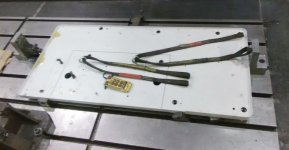will gilmore
Aluminum
- Joined
- Feb 6, 2007
- Location
- New York City
This is a new one for me. I need to hold 9"x9"x1" A36 plates in a 6" vice. Nothing too strenuous. Drill/tap a few holes. Alignment not critical. Material is potentially saw cut by supplier. -0 +1/16" no spec on parallelism. I was thinking of putting a jaw with a step on the back of the vice and another one on the front of the moving jaw but I'm worried about the surface and parallelism of the material. Any tricks here?



